Finite Difference Modeling of Time Fractal Impact on Unsteady Magneto-hydrodynamic Darcy–Forchheimer Flow in Non-Newtonian Nanofluids with the q-Derivative
Abstract
:1. Introduction
- To create a mathematical model of the Williamson nanofluid’s unsteady MHD Darcy–Forchheimer flow, considering the effects of the nanoparticles, magnetic field, and porous media.
- To properly reflect the complex dynamics of time fractal events by incorporating the idea of q-derivatives into the spatial discretization scheme.
- To better understand the complex behavior of time-dependent flow parameters, such as velocities, temperatures, and concentration profiles, in the presence of magnetic fields and porous media by developing and analyzing a finite difference scheme to generate numerical solutions.
2. Proposed Numerical Scheme
3. Stability Analysis
4. Problem Formulation
5. Results and Discussions
6. Conclusions
- Intensifying the magnetic field parameter, porosity parameter, inertia coefficient, and Weisenberg number decreased the velocity profile.
- The temperature profile increased when the Brownian motion parameter values and thermophoresis parameters were increased.
- As the value of the Brownian motion parameter increased, the concentration profile dipped.
Author Contributions
Funding
Data Availability Statement
Acknowledgments
Conflicts of Interest
References
- Choi, S.U.S.; Eastman, J.A. Enhancing Thermal Conductivity of Fluids with Nanoparti-Cles; ASME International Mechanical Engineering Congress & Exposisition; American Society of Mechanical Engineers: San Francisco, FL, USA, 1995; Volume 66, pp. 99–105. [Google Scholar]
- Rasool, G.; Zhang, T. Characteristics of chemical reaction and convective boundary conditions in Powell-Eyring nanofluid flow along a radiative Riga plate. Heliyon 2019, 5, e01479. [Google Scholar] [CrossRef] [PubMed]
- Bai, Y.; Liu, X.; Zhang, Y.; Zhang, M. Stagnation-point heat and mass transfer of MHD Maxwell nanofluids over a stretching surface in the presence of thermophoresis. J. Mol. Liq. 2016, 224, 1172–1180. [Google Scholar] [CrossRef]
- Jusoh, R.; Nazar, R.; Pop, I. Flow and heat transfer of magneto-hydrodynamic three-dimensional Maxwell nanofluid over a permeable stretching/shrinking surface with convective boundary conditions. Int. J. Mech. Sci. 2018, 124, 166–173. [Google Scholar]
- Dogonchi, A.S.; Chamkha, A.J.; Ganji, D.D. A numerical investigation of magneto-hydrodynamic natural convection of Cu-water nanofluid in a wavy cavity using CVFEM. J. Therm. Anal. Calorim. 2019, 135, 2599–2611. [Google Scholar] [CrossRef]
- Sakiadis, B.C. Boundary-layer behavior on continuous solid surfaces: Boundary-layer equations for two-dimensional and axisymmetric flow. AIChE J. 1961, 7, 26–28. [Google Scholar] [CrossRef]
- Crane, L.J. Flow past a stretching plate. Angew. Math. Phys. 1970, 21, 645. [Google Scholar] [CrossRef]
- Rasool, G.; Shafiq, A.; Khalique, C.M.; Zhang, T. Magneto-hydrodynamic Darcy Forchheimer nanofluid flow over nonlinear stretching sheet. Phys. Scr. 2019, 94, 105221. [Google Scholar] [CrossRef]
- Rasool, G.; Zhang, T. Darcy-Forchheimer nanofluidic flow manifested with Cattaneo-Christov theory of heat and mass flux over nonlinearly stretching surface. PLoS ONE 2019, 14, e0221302. [Google Scholar] [CrossRef]
- Sandeep, N.; Sulochana, C.; Kumar, B.R. UnsteadyMHDradiative flow and heat transfer of a dusty nanofluid over an exponentially stretching surface. Eng. Sci. Technol. 2016, 19, 227–240. [Google Scholar]
- Hayat, T.; Qayyum, S.; Alsaedi, A.; Shafiq, A. Inclined magnetic field and heat source/sink aspects in flow of nanofluid with nonlinear thermal radiation. Int. J. Heat Mass Transf. 2016, 103, 99–107. [Google Scholar] [CrossRef]
- Ziaei-Rad, M.; Saeedan, M.; Afshari, E. Simulation and prediction of MHD dissipative nanofluid flow on a permeable stretching surface using artificial neural network. Appl. Therm. Eng. 2016, 99, 373–382. [Google Scholar] [CrossRef]
- Williamson, R.V. The flow of pseudoplastic materials. Ind. Eng. Chem. 1929, 21, 1108–1111. [Google Scholar] [CrossRef]
- Blasius, H. The Boundary Layers in Fluids with Little Friction; NACA: Washington, DC, USA, 1950. [Google Scholar]
- Ramesh, G.K.; Gireesha, B.J.; Gorla, R.S.R. Study on Sakiadis and Blasius flows of Williamson fluid with convective boundary condition. Nonlinear Eng. 2015, 4, 215–221. [Google Scholar] [CrossRef]
- Khan, M.; Malik, M.Y.; Salahuddin, T.; Rehman, K.U.; Naseer, M.; Khan, I. MHD flow of Williamson nanofluid over a cone and plate with chemically reactive species. J. Mol. Liq. 2017, 231, 580–588. [Google Scholar] [CrossRef]
- Hayat, T.; Bashir, G.; Waqas, M.; Alsaedi, A. MHD 2D flow ofWilliamson nanofluid over a nonlinear variable thicked surface with melting heat transfer. J. Mol. Liq. 2016, 223, 836–844. [Google Scholar] [CrossRef]
- Nadeem, S.; Hussain, S.T.; Lee, C. Flow of aWilliamson fluid over a stretching sheet. Braz. J. Chem. Eng. 2013, 30, 619–625. [Google Scholar] [CrossRef]
- Salahuddin, T.; Malik, M.Y.; Hussain, A.; Bilal, S.; Awais, M. MHD Flow of Cattanneo-Christov heat flux model for Williamson fluid over a stretching sheet with variable thickness: Using numerical approach. J. Magn. Magn. Mater. 2016, 401, 991–997. [Google Scholar] [CrossRef]
- Hayat, T.; Saeed, Y.; Asad, S.; Alsaedi, A. Soret and Dufour effects in the flow ofWilliamson fluid over an unsteady stretching surface with thermal radiation. Z. Naturforschung A 2015, 70, 235–243. [Google Scholar] [CrossRef]
- Buongiorno, J. Convective transport in nanofluids. J. Heat Transfer. 2006, 128, 240–250. [Google Scholar] [CrossRef]
- Tiwari, R.K.; Das, M.K. Heat transfer augmentation in a two sided lid-driven differentially heated square cavity utilizing nanofluid. Int. J. Heat Mass Transf. 2007, 50, 2002–2018. [Google Scholar] [CrossRef]
- Makinde, O.D.; Chinyoka, T. MHD transient flows and heat transfer of dusty fluid in a channel with variable physical properties and Navier slip condition. Comput. Math. Appl. 2010, 60, 660–669. [Google Scholar] [CrossRef]
- Jalilpour, B.; Jafarmadar, S.; Rashidi, M.M.; Ganji, D.D.; Rahime, R.; Shotorban, A.B. MHD non-orthogonal stagnation point flow of a nanofluid towards a stretching surface in the presence of thermal radiation. Ain Shams Eng. J. 2017, 9, 1671–1681. [Google Scholar] [CrossRef]
- Sandeep, N. Effect of aligned magnetic field on liquid thin film flow of magnetic-nanofluids embedded with graphene nanoparticles. Adv. Powder Technol. 2017, 28, 865–875. [Google Scholar] [CrossRef]
- Sucharitha, G.; Lakshminarayana, P.; Sandeep, N. Joule heating and wall flexibility effects on the prristaltic flow of magneto-hydrodynamic nanofluid. Int. J. Mech. Sci. 2017, 131–132, 52–62. [Google Scholar] [CrossRef]
- Nadeem, S.; Hussain, S.T. Flow and heat transfer analysis of Williamson nanofluid. Appl. Nanosci. 2014, 4, 1005–1012. [Google Scholar] [CrossRef]
- Krishnamurthy, M.R.; Prasannakumara, B.C.; Gireesha, B.J.; Gorla, R.S.R. Effect of chemical reaction on MHD boundary layer flow and melting heat transfer of Williamson nanofluid in porous medium. Eng. Sci. Technol. Int. J. 2016, 19, 53–61. [Google Scholar] [CrossRef]
- Forchheimer, P. Wasserbewegung durch boden. Z. Ver. Dtsch. Ing. 1901, 45, 1782–1788. [Google Scholar]
- Muskat, M.; Meres, M.W. The flow of heterogeneous fluids through porous media. Physics 1936, 7, 346–363. [Google Scholar] [CrossRef]
- Sadiq, M.A.; Hayat, T. Darcy-Forchheimer flow of magneto Maxwell liquid bounded by convectively heated sheet. Results Phys. 2016, 6, 884–890. [Google Scholar] [CrossRef]
- Khan, A.; Shah, Z.; Islam, S.; Khan, S.; Khan, W.; Khan, A.Z. Darcy-Forchheimer flow of micropolar nanofluid between two plates in the rotating frame with non-uniform heat generation/absorption. Adv. Mech. Eng. 2018, 10, 1–16. [Google Scholar] [CrossRef]
- Hayat, T.; Haider, F.; Muhammad, T.; Alsaedi, A. Darcy-Forchheimer flow due to a curved stretching surface with Cattaneo-Christov double diffusion: A numerical study. Results Phys. 2017, 7, 2663–2670. [Google Scholar] [CrossRef]
- Muhammad, T.; Rafique, K.; Asma, M.; Alghamdi, M. Darcy-Forchheimer flow over an exponentially stretching curved surface with Cattaneo-Christov double diffusion. Phys. A 2019, 556, 123968. [Google Scholar] [CrossRef]
- Hayat, T.; Saif, R.S.; Ellahi, R.; Muhammad, T.; Ahmad, B. Numerical stuy for Darcy-Forchheimer flow due to a curved stretching surface with Cattaneo-Christov heat flux and homogeneous-hetrogeneous reactions. Results Phys. 2017, 7, 2886–2892. [Google Scholar] [CrossRef]
- Rasool, G.; Zhang, T.; Chamkha, A.J.; Shafiq, A.; Tlili, I.; Shahzadi, G. Entropy generation and consequences of binary chemical reaction on MHD Darcy–Forchheimer Williamson Nanofluid flow over nonlinearly stretching surface. Entropy 2020, 22, 18. [Google Scholar] [CrossRef] [PubMed]
- Khan, Z.A.; Shah, K.; Abdalla, B.; Abdeljawad, T. A numerical Study of Complex Dynamics of a Chemostat Model Under Fractal-Fractional Derivative. Fractals 2023, 31, 2340181. [Google Scholar] [CrossRef]
- Sana, G.; Mohammed, P.O.; Shin, D.Y.; Noor, M.A.; Oudat, M.S. On iterative methods for solving nonlinear equations in Quantum calculus. Fractal Fract. 2021, 5, 60. [Google Scholar] [CrossRef]
- Nawaz, Y.; Arif, M.S.; Abodayeh, K. An explicit-implicit numerical scheme for time fractional boundary layer flows. Int. J. Numer. Methods Fluids 2022, 94, 920–940. [Google Scholar] [CrossRef]
- Nawaz, M.; Adil Sadiq, M. Unsteady heat transfer enhancement in Williamson fluid in Darcy-Forchheimer porous medium under non-Fourier condition of heat flux. Case Stud. Therm. Eng. 2021, 28, 101647. [Google Scholar] [CrossRef]
- Kho, Y.B.; Hussanan, A.; Mohamed, M.K.A.; Salleh, M.Z. Heat and mass transfer analysis on flow of Williamson nanofluid with thermal and velocity slips: Buongiorno model. Propuls. Power Res. 2019, 8, 243–252. [Google Scholar] [CrossRef]
- Nawaz, Y.; Arif, M.S.; Abodayeh, K. A Compact Numerical Scheme for the Heat Transfer of Mixed Convection Flow in Quantum Calculus. Appl. Sci. 2022, 12, 4959. [Google Scholar] [CrossRef]
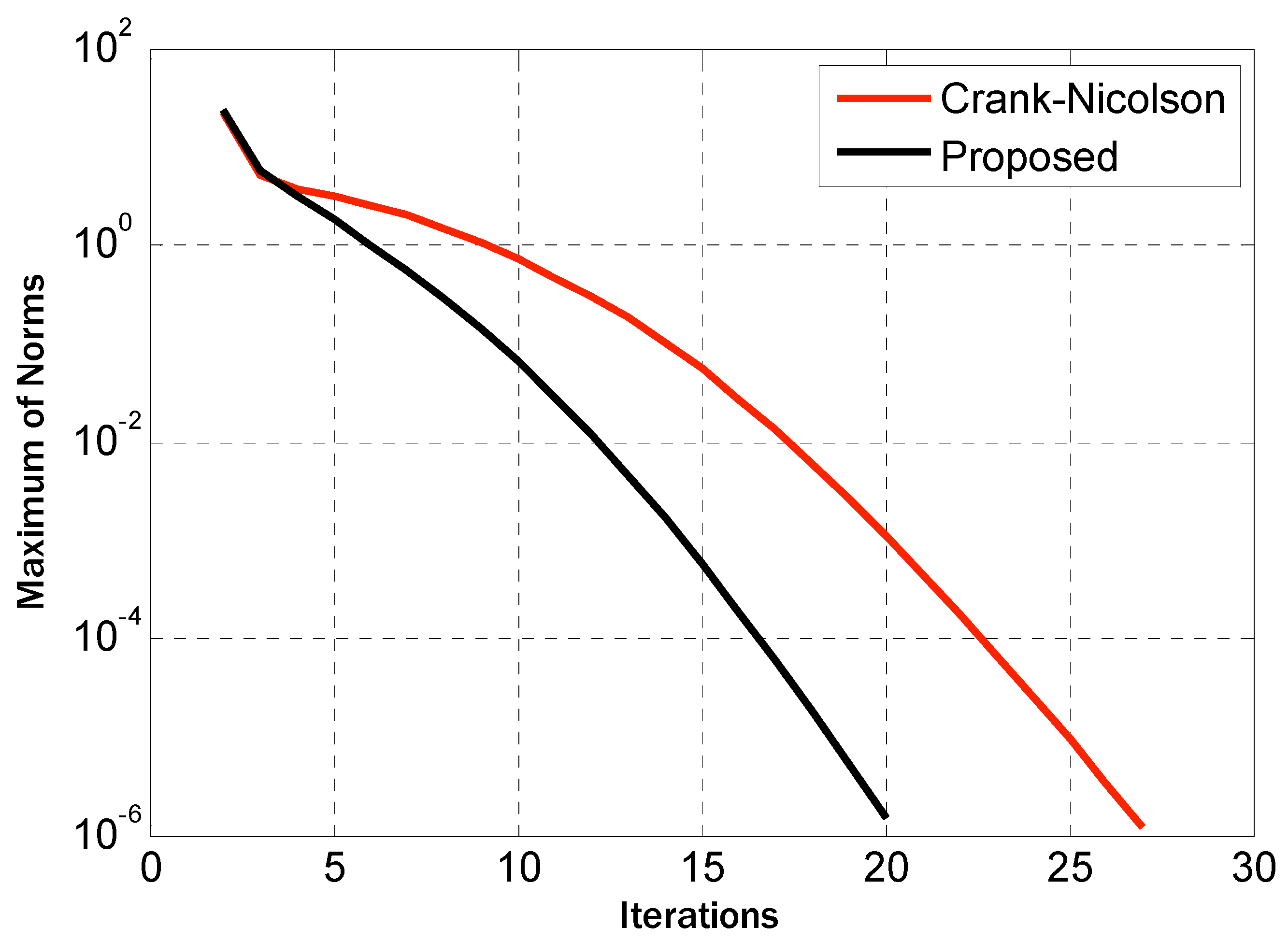
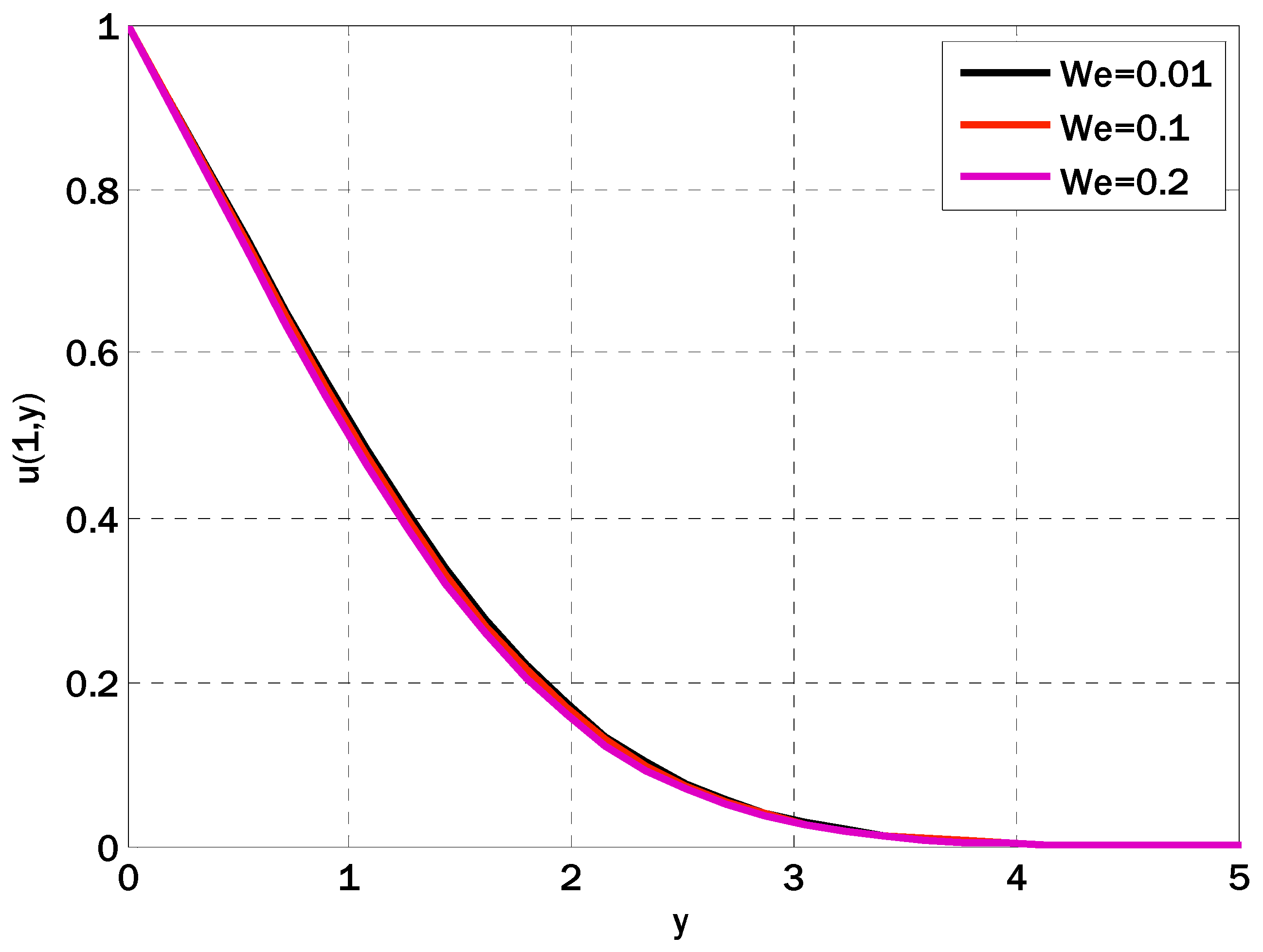

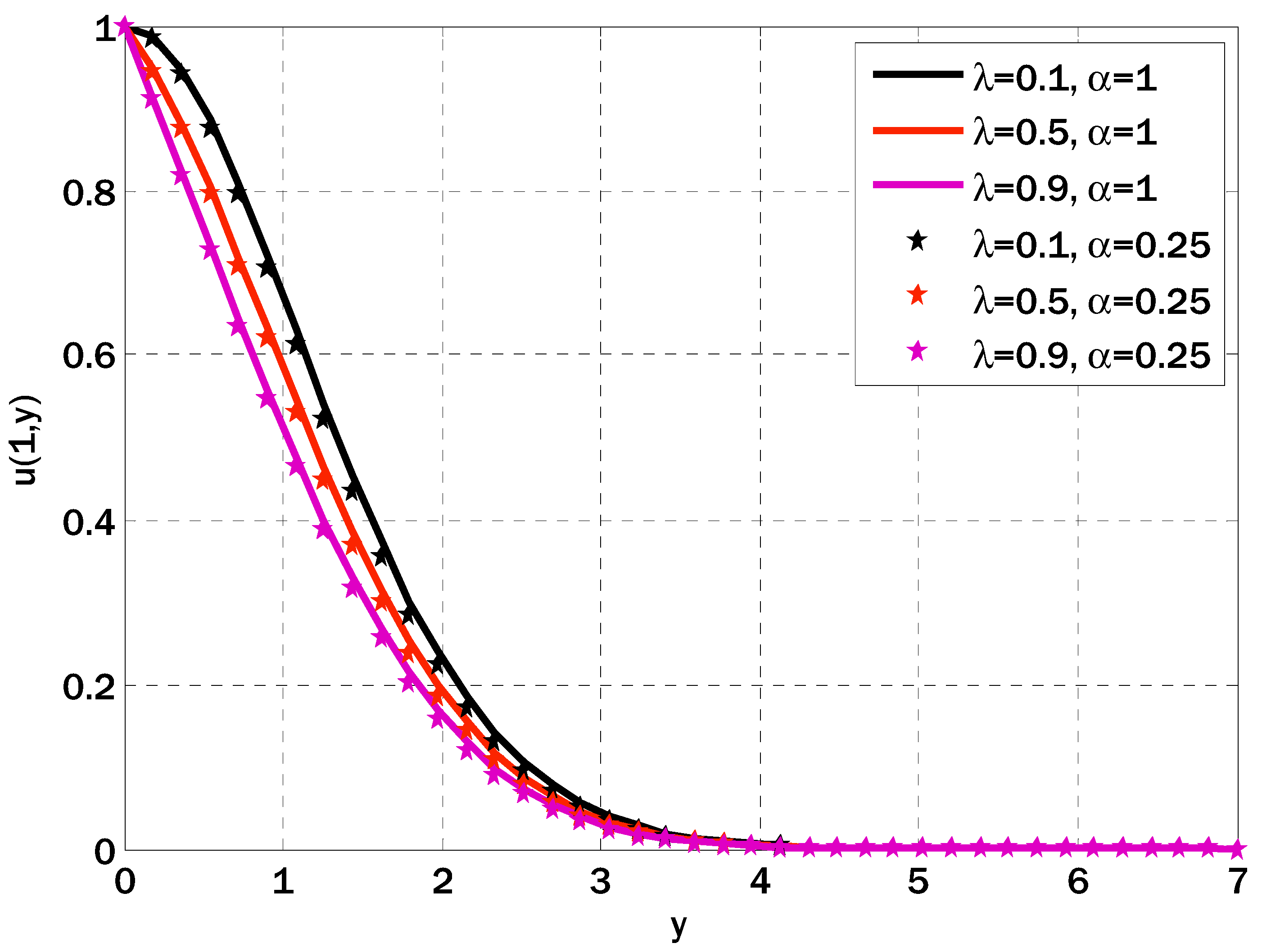
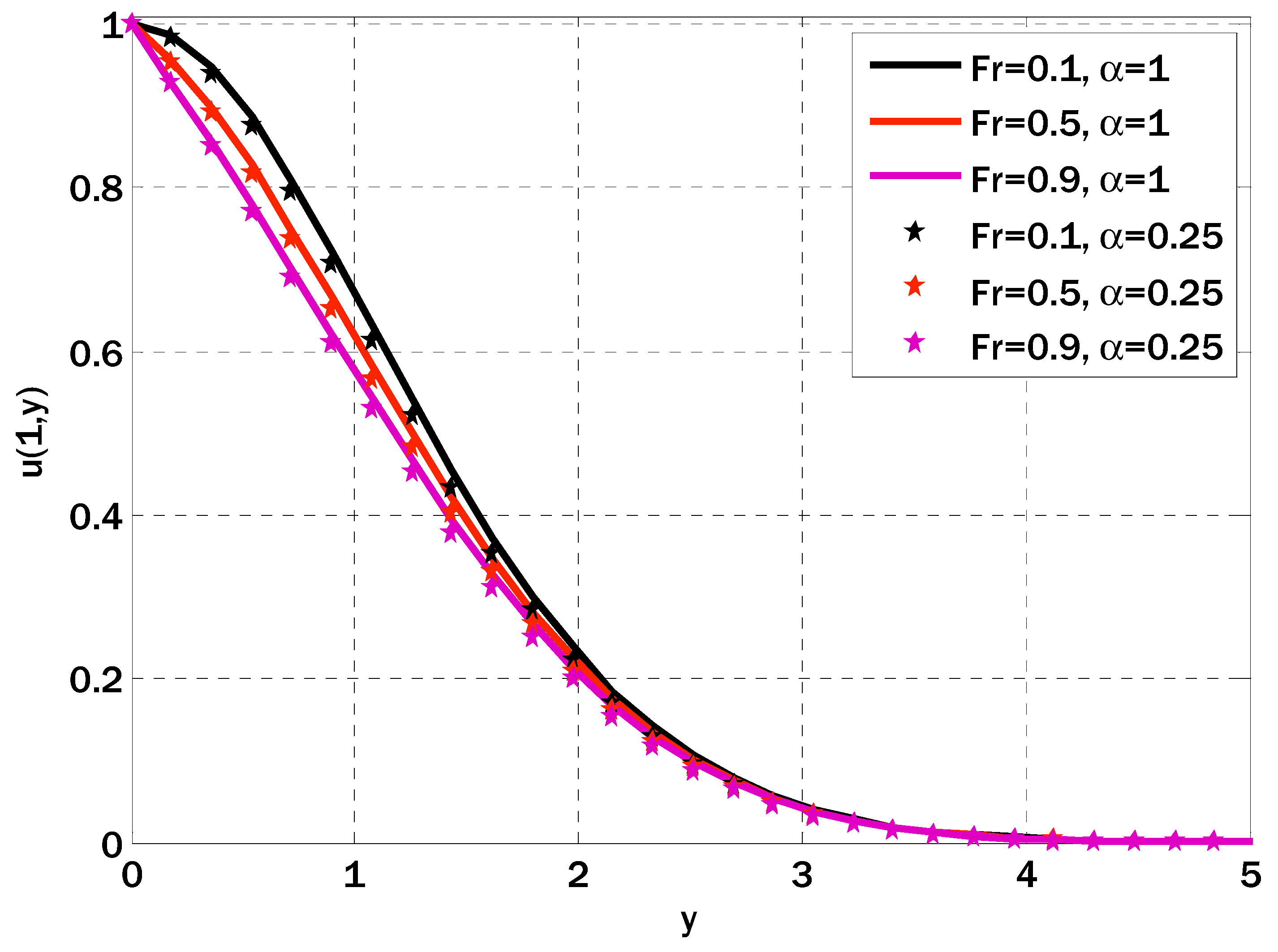
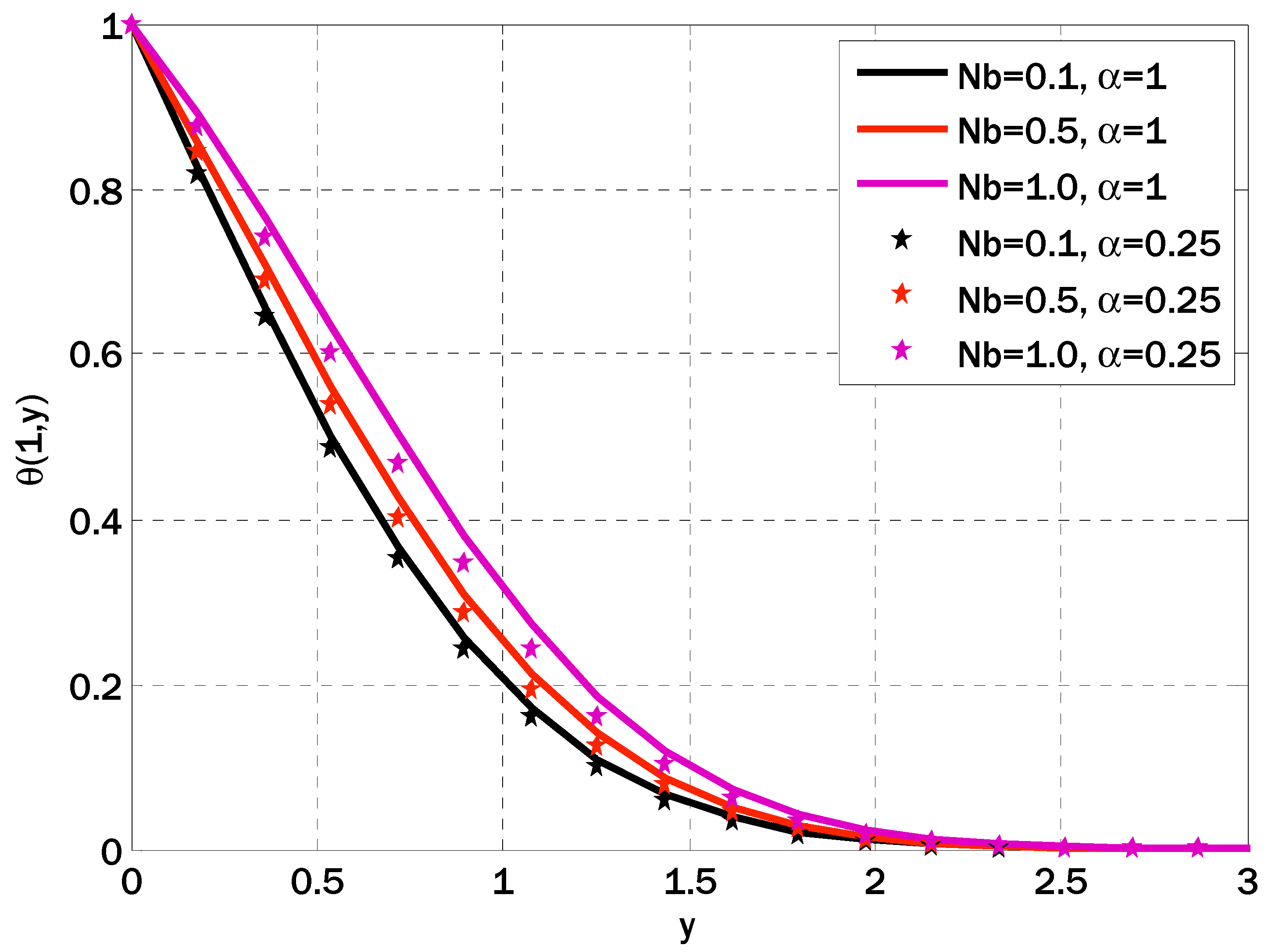


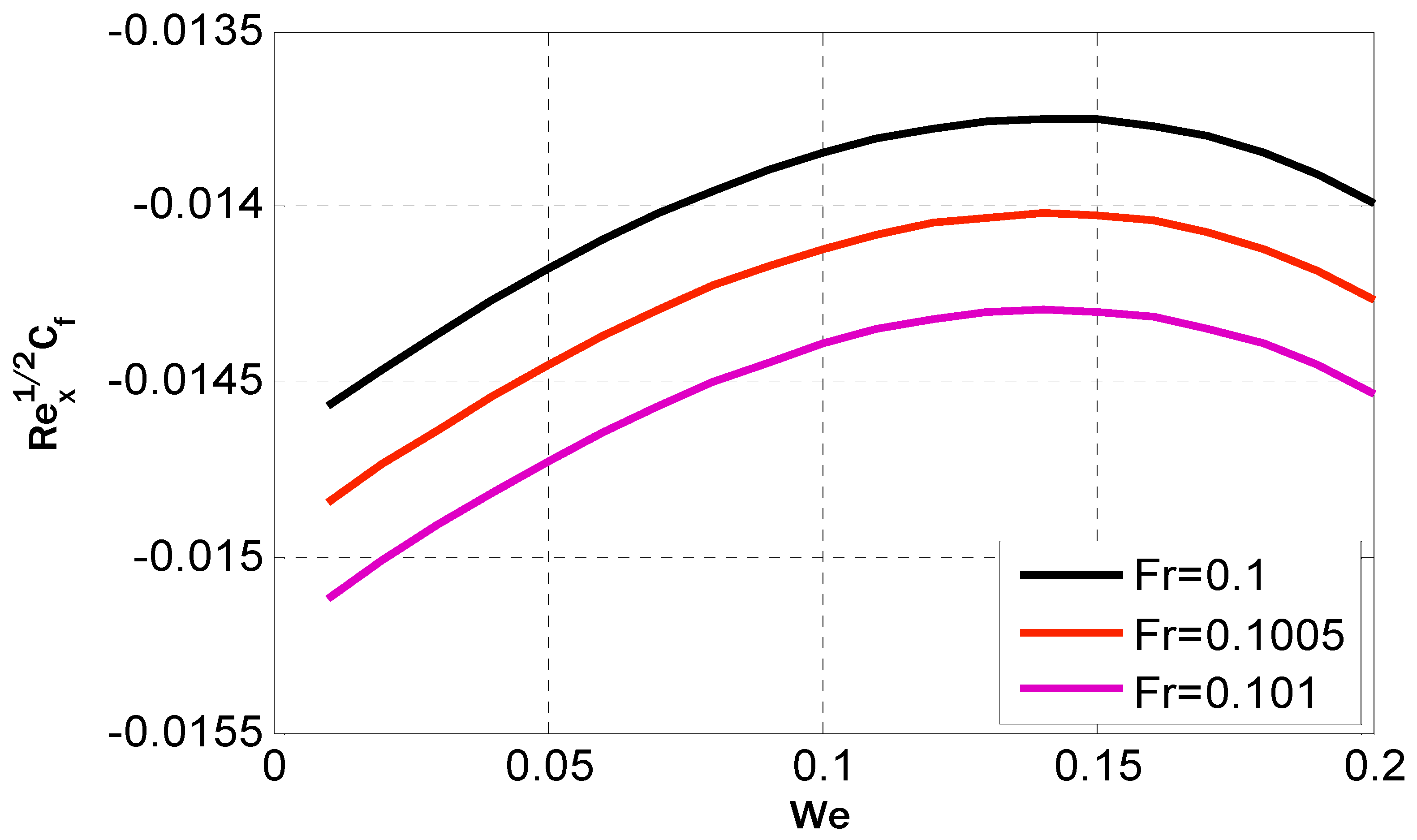
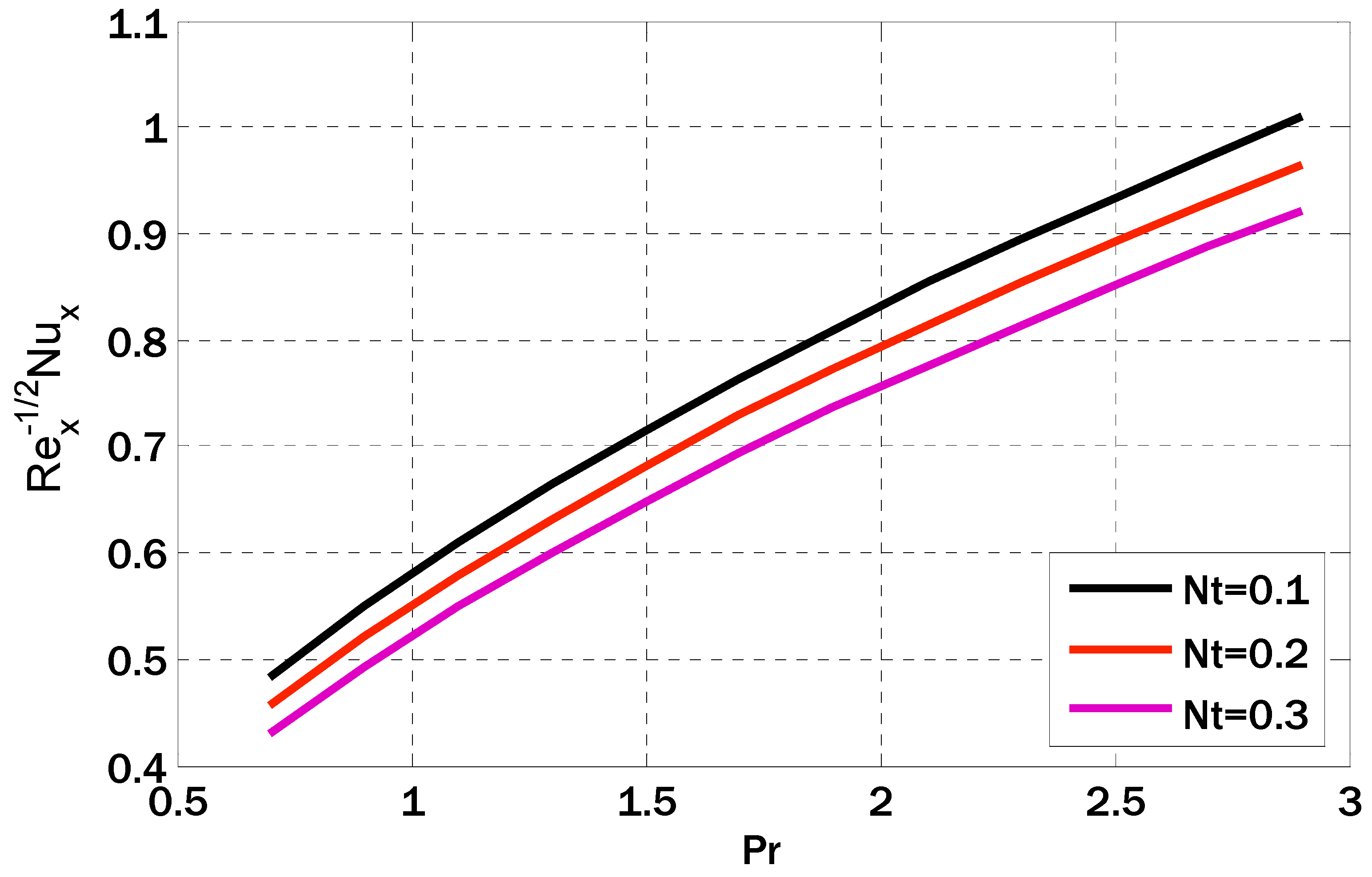

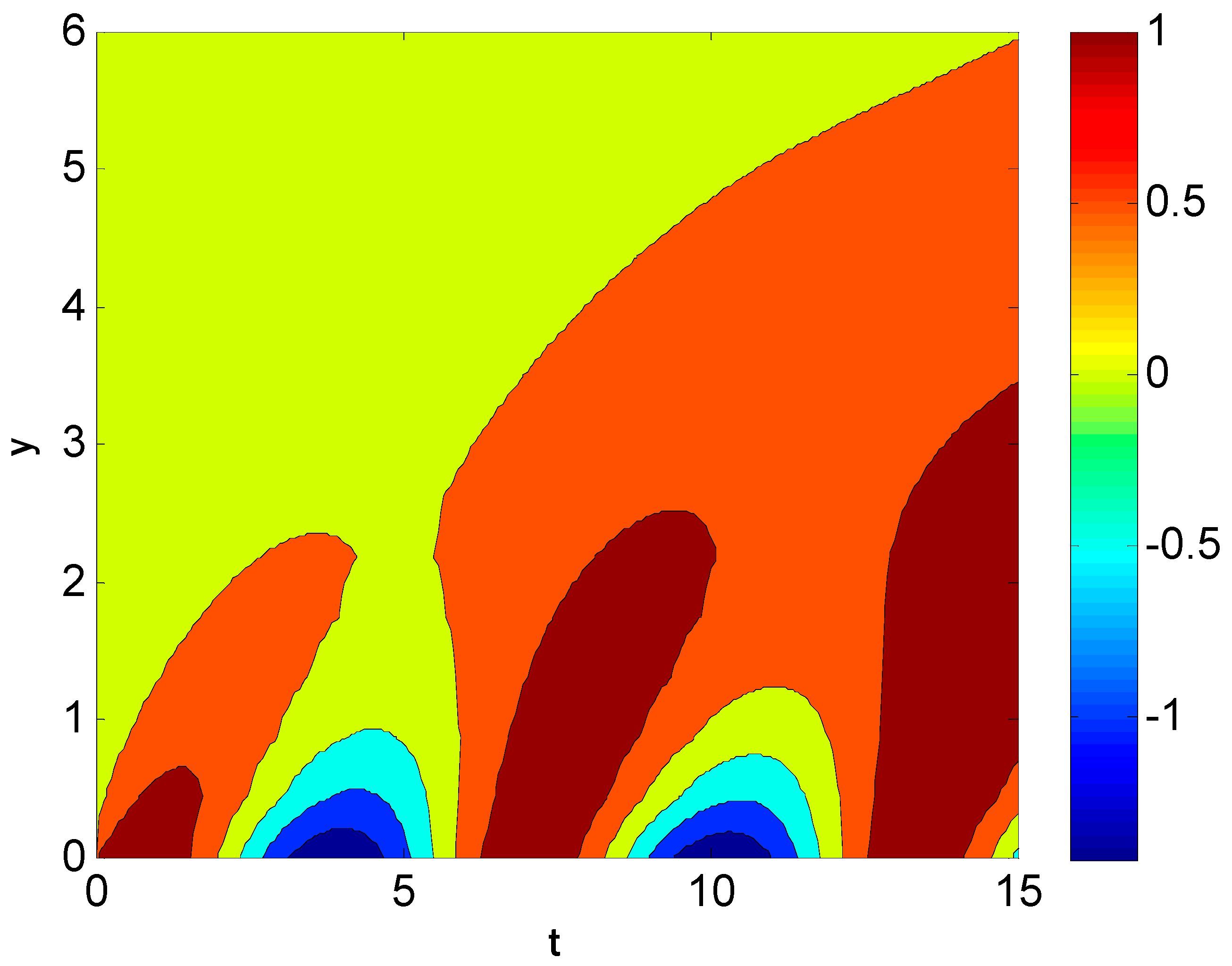
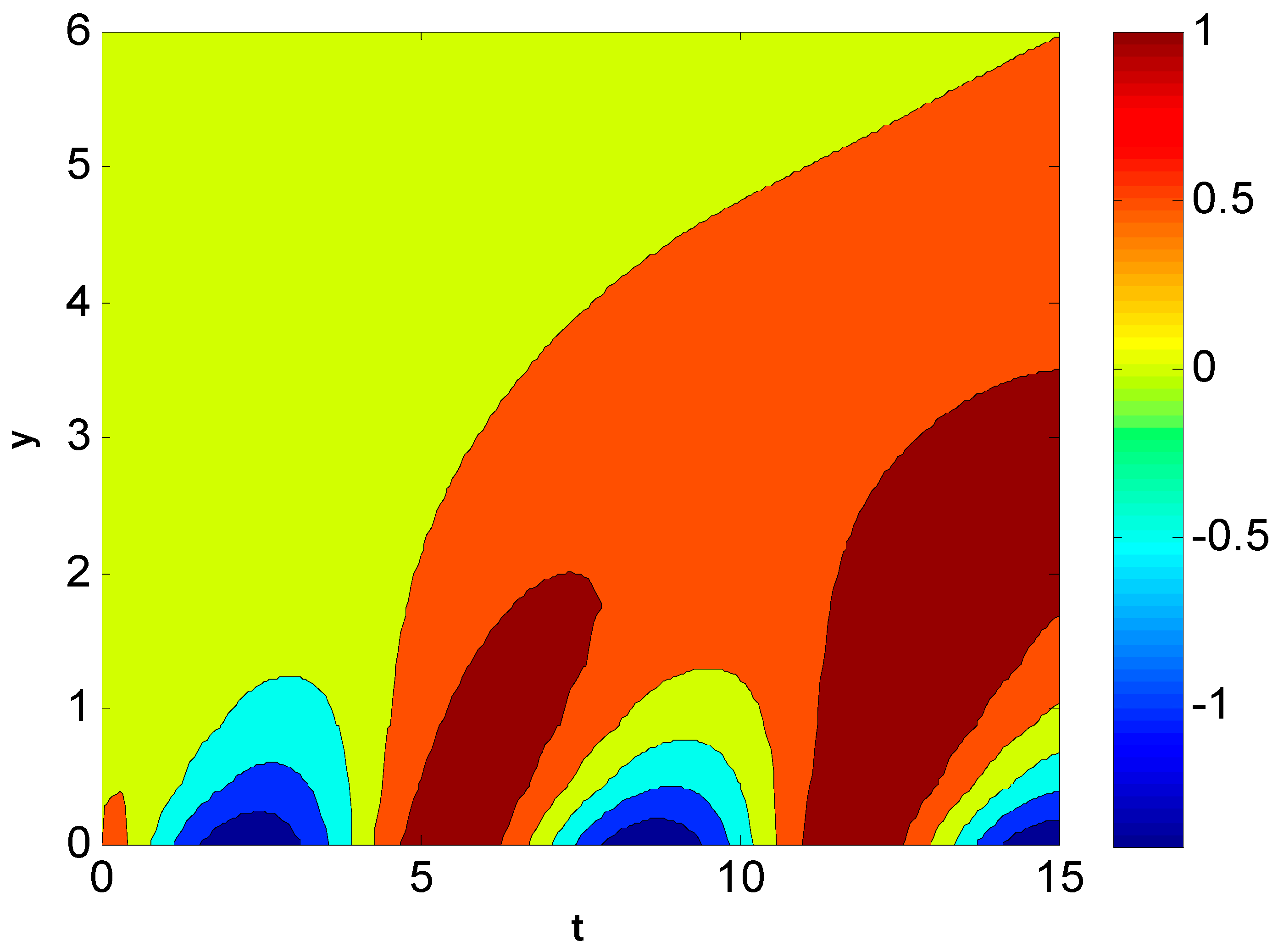
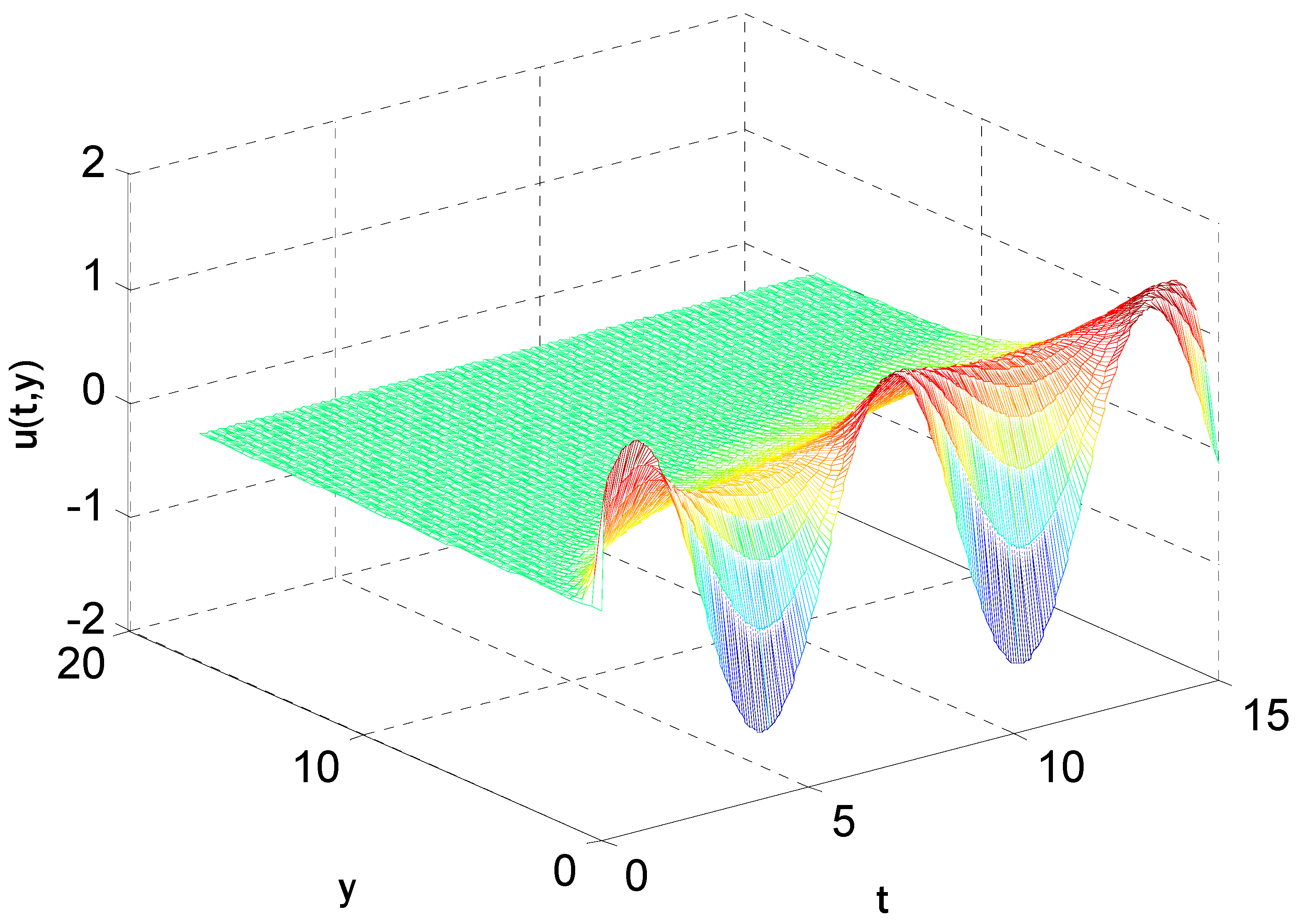
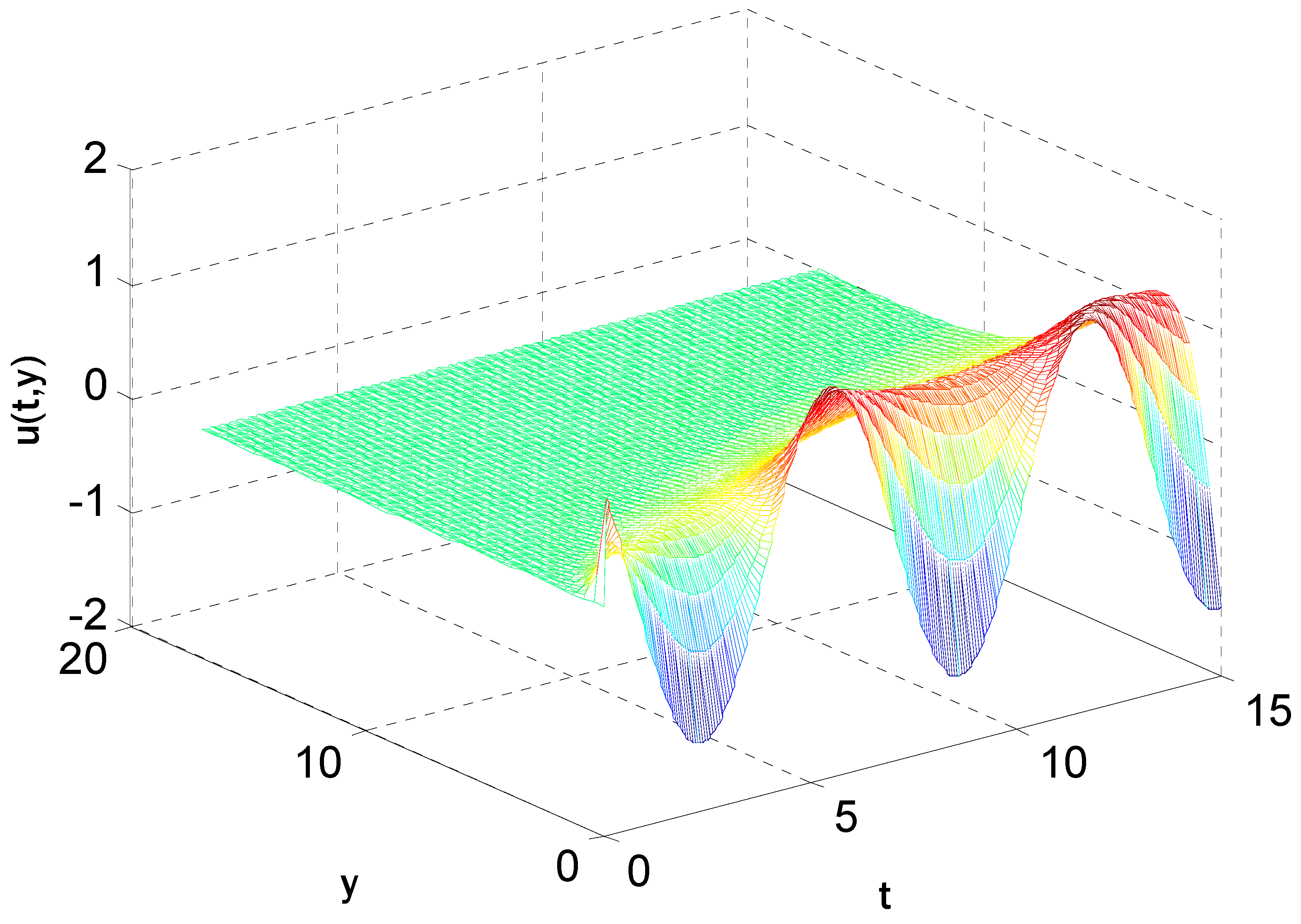
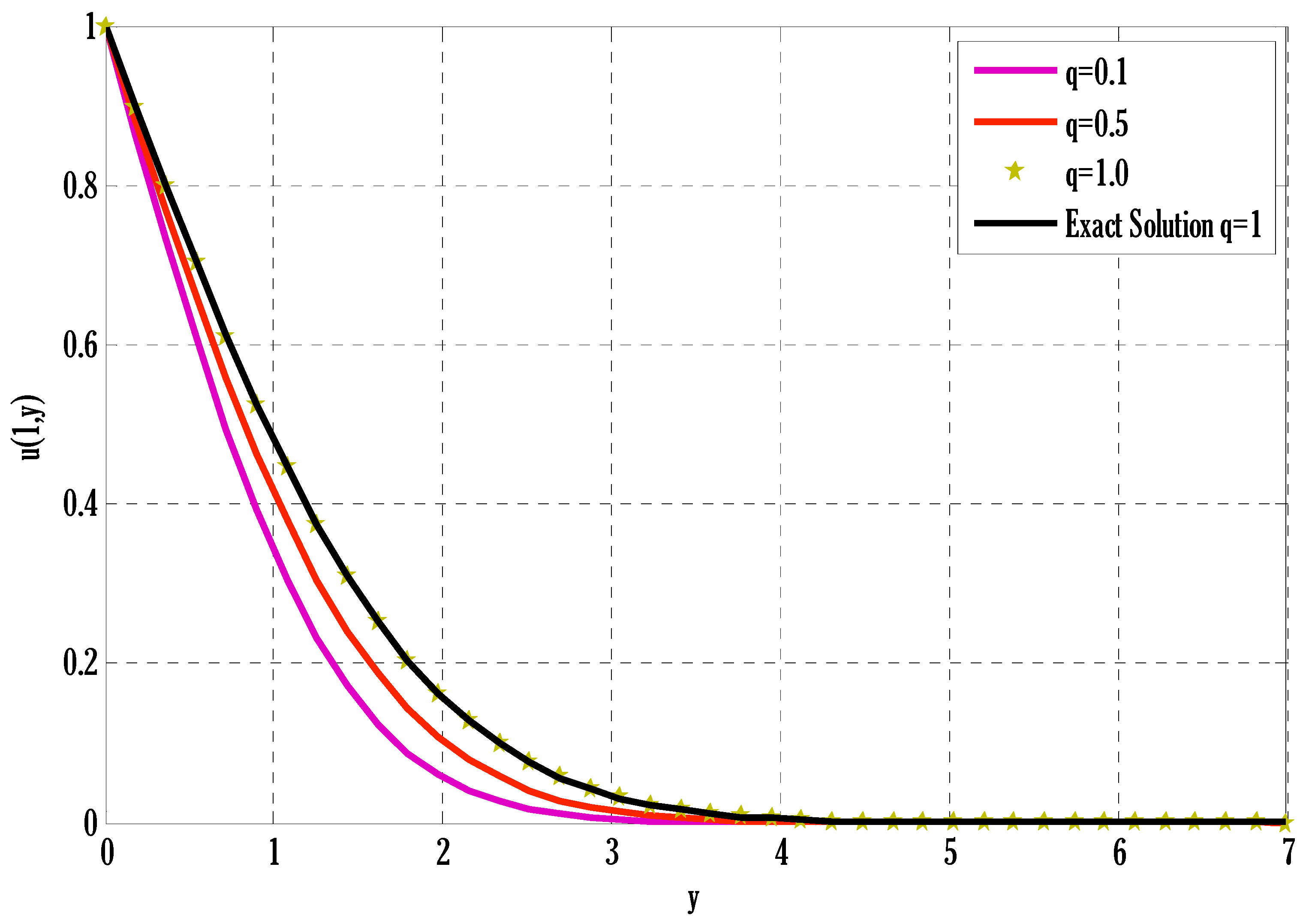
| Time Levels | Grid Points | Time | |
|---|---|---|---|
| Crank–Nicolson | Proposed | ||
| 250 | 25 | 0.6170 | 1.1131 |
| 50 | 3.6139 | 4.6852 | |
| 100 | 18.3235 | 24.1248 | |
| 500 | 25 | 1.4000 | 2.5211 |
| 50 | 6.5681 | 8.7674 | |
| 100 | 34.8341 | 44.8464 | |
Disclaimer/Publisher’s Note: The statements, opinions and data contained in all publications are solely those of the individual author(s) and contributor(s) and not of MDPI and/or the editor(s). MDPI and/or the editor(s) disclaim responsibility for any injury to people or property resulting from any ideas, methods, instructions or products referred to in the content. |
© 2023 by the authors. Licensee MDPI, Basel, Switzerland. This article is an open access article distributed under the terms and conditions of the Creative Commons Attribution (CC BY) license (https://creativecommons.org/licenses/by/4.0/).
Share and Cite
Baazeem, A.S.; Nawaz, Y.; Arif, M.S. Finite Difference Modeling of Time Fractal Impact on Unsteady Magneto-hydrodynamic Darcy–Forchheimer Flow in Non-Newtonian Nanofluids with the q-Derivative. Fractal Fract. 2024, 8, 8. https://doi.org/10.3390/fractalfract8010008
Baazeem AS, Nawaz Y, Arif MS. Finite Difference Modeling of Time Fractal Impact on Unsteady Magneto-hydrodynamic Darcy–Forchheimer Flow in Non-Newtonian Nanofluids with the q-Derivative. Fractal and Fractional. 2024; 8(1):8. https://doi.org/10.3390/fractalfract8010008
Chicago/Turabian StyleBaazeem, Amani S., Yasir Nawaz, and Muhammad Shoaib Arif. 2024. "Finite Difference Modeling of Time Fractal Impact on Unsteady Magneto-hydrodynamic Darcy–Forchheimer Flow in Non-Newtonian Nanofluids with the q-Derivative" Fractal and Fractional 8, no. 1: 8. https://doi.org/10.3390/fractalfract8010008
APA StyleBaazeem, A. S., Nawaz, Y., & Arif, M. S. (2024). Finite Difference Modeling of Time Fractal Impact on Unsteady Magneto-hydrodynamic Darcy–Forchheimer Flow in Non-Newtonian Nanofluids with the q-Derivative. Fractal and Fractional, 8(1), 8. https://doi.org/10.3390/fractalfract8010008







